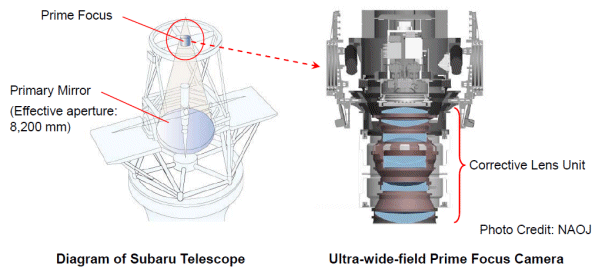News Release
Canon technology contributes to Subaru Telescope's wide field of view
TOKYO, September 13, 2012— Canon Inc. announced today that the Hyper Suprime-Cam*1 (HSC) ultra-wide-field second-generation prime focus camera, equipped with a corrector lens*2 that was developed and produced by Canon Inc., has recently been installed in the Subaru Telescope and began undergoing performance testing on August 28 (Hawaii-Aleutian Standard Time).
The large-scale optical-infrared Subaru Telescope, located at the summit of Mauna Kea, Hawaii, and operated by the National Astronomical Observatory of Japan (NAOJ), commenced scientific observation in 1999. To make possible a wider field of view, the NAOJ, working in cooperation with multiple research institutes, including the Kavli Institute for the Physics and Mathematics of the Universe (Kavli IPMU), Todai Institutes for Advanced Study, developed the large-field-of-view HSC, entrusting Canon with the responsibility of developing and producing the camera's corrector lens unit.
Maximum angle of view expanded approximately three-fold
Because the HSC was to be installed within the existing structure of the telescope, the corrector lens unit had to satisfy a number of strict restrictions in terms of mass and dimensions. Calling on the design technologies cultivated by the company over many years, along with measuring and precision-machining technologies newly developed for the task at hand, Canon succeeded in expanding the lens's maximum angle of view from the 0.5 degrees realized by the first-generation Suprime-Cam*3 (SC), to 1.5 degrees. Although the new corrector lens makes possible an angle of view approximately three times greater than that of the SC through the use of aspherical lenses, it employs only seven lens elements, the same number used in the SC, and has a lens diameter that is only approximately 1.6-times larger.
Through a range of space observation equipment, including the ultra-wide-field HSC, the amount of time required to survey a region of the sky that had previously been estimated at 16 years is now expected to be possible in only two years.
Reduced weight through advanced measuring and precision-machining technologies
Although the processing of aspherical lenses becomes increasingly difficult as lens size increases, through the use of precision measuring and machining devices produced in-house, Canon was able to create aspherical lens elements that deliver advanced imaging performance equivalent to that realized by the Suprime-Cam corrector lens. Additionally, the unit's lens barrel, which ensures that the lens delivers consistently high precision, newly employs a ceramic material that achieves a significant reduction in weight compared with the material used in the previous lens barrel. The production of the ceramic lens barrel also made use of Canon's precision machining technologies.
- *1The Hyper Suprime-Cam is an observation instrument located at the Subaru Telescope's prime focus that makes possible wide-coverage observation. Among telescopes with a primary mirror measuring more than 8 m in diameter, Subaru Telescope is the only one to be equipped with an observational instrument at prime focus. (As of Sept. 13, 2012, based on a National Astronomical Observatory of Japan survey)
- *2The corrector lens is a lens unit that corrects aberrations in the light gathered by the telescope's primary mirror to make possible high imaging performance.
- *3Abbreviation of Subaru Prime Focus Camera
Subaru Telescope and Ultra-wide-field Prime Focus Camera

Corrector Lens Comparison: Hyper Suprime-Cam vs. Suprime-Cam
| Hyper Suprime-Cam Corrector Lens |
Suprime-Cam Corrector Lens |
||
|---|---|---|---|
| Lens | Angle of view | 1.5 degrees | 0.5 degrees |
| Imaging performance | 0.2 arc seconds | 0.2 arc seconds | |
| Maximum effective diameter | Approx. 820 mm | Approx. 507 mm | |
| Lens construction | 7 elements in 7 groups | 7 elements in 5 groups | |
| No. of aspherical surfaces | 5 surfaces | 2 surfaces | |
| Maximum asphericity | Approx. 4.89 mm | Approx. 0.14 mm | |
| Lens Barrel | External diameter | Approx. 970 mm | Approx. 600 mm |
| Length | Approx. 1,664 mm | Approx. 690 mm | |
| Weight | Approx. 872 kg | Approx. 170 kg | |
About Subaru Telescope
Since beginning scientific observation in 1999, the Subaru Telescope has set new records in the discovery of most-distant galaxies, contributing to various space observation efforts.
Progress in space research has led to the discovery of a number of new mysteries of the cosmos, such as dark matter and dark energy. With the completion of the Hyper Suprime-Cam, enabling the wide-field viewing of space, expectations are high that research efforts can be further accelerated toward the uncovering of the origins and the future of our universe.
Through the company's technology, Canon will continue contributing to the development of the world's science and technology.
